| Aisne-Marne Offensive, France, 18 July—19 July, 1918. |
| Soissons — The Battle of Vierzy
|
|
- 1918
- Verte Feuille Farm
- Post Offensive
- Maps
- Related pages
1918
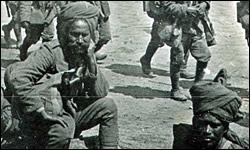 |
Partners of Americans in Marne Counter-Offensive —
French Moroccan Troops on Villers-Cotterêts Road.
July 1918. |
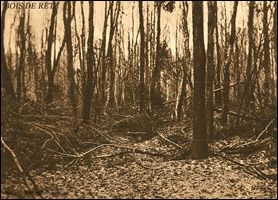 |
BOIS DE RETZ. "On the night of July 16, 1918, the Fourth Brigade of Marines moved in camions from the neighborhood of Nanteuil-sur-Marne for the offensive south of Soissons. |
![Large tank [Saint-Chamond] operated by the French. Chavigny, France.](../../_div.images/aef.nara/thumbs/17680.jpg) |
Large tank [Saint-Chamond] operated by the French.
Chavigny, France, July 18, 1918. |
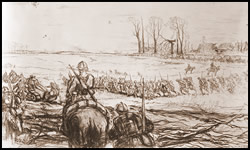 |
French light tanks and French Colonial Infantry and American Artillery moving forward in the region of Ploisy
on the morning of July 19, 1918.
Capt Wallace Morgan |
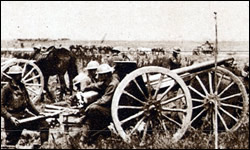 |
15th F. A. in action near Vauxcastille.
July 19, 1918. |
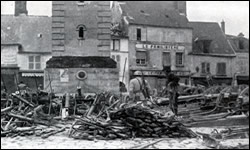 |
Captured Weapons in Public Square in Villers-Cotterêts.
July 27, 1918. |
|
| |
Verte Feuille Farm
| |
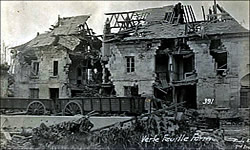 |
Verte Feuille Farm
Photo by 2nd Engineers
July 1918. |
|
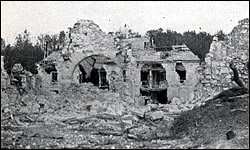 |
La Verte-Feuille Farm After Its Capture by the 2d Division.
July 18, 1918. |
|
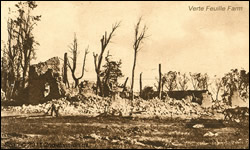 |
The Verte Feuille Farm was taken by the 2d Bn., 5th Marines, on the morning of July 18, 1918. Maj. Ralph Kayser was the commanding officer. The units in battalion were: 18th Co., Capt. L. S. Wass; 43d Co., Capt. J. D. Murray; 51st Co., Capt. W. O. Corbin; 55th Co., Lt. E. Cook, N. A. |
|
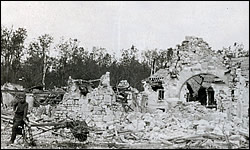 |
Verte-Feuille Farm after American Artillery, 2nd Division, finished.
July 19, 1918. Soissons Front, France. |
|
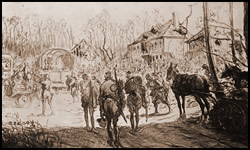 |
Cross road at Vertes-Feuilles on the edge of the Bois de Villere Cotterets,
morning of July 19, 1918.
Capt Wallace Morgan, E.C. |
|
| |
Post Offensive
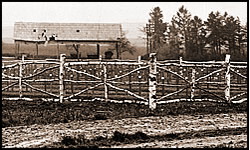 |
General view of cemetery at Vierzy. This cemetery was established by Unit "B" Graves Registration Service and was completed about November 5, 1918. It contains 208 bodies of American Soldiers.
Vierzy, France. December 5, 1918. |
|
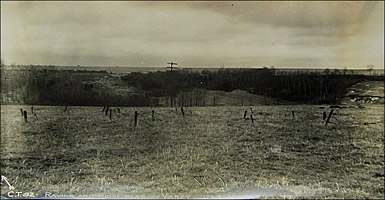 |
Ravine and Ridge, Rear of Vierzy. February 27, 1919
Image used with permission.
|
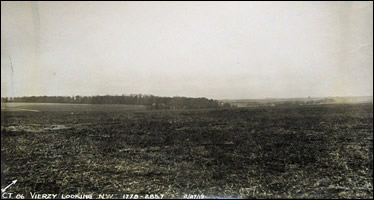 |
Vierzy Looking NW February 27, 1919
Image used with permission.
|
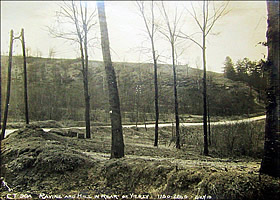 |
Ravine and Hill in Rear of Vierzy February 27, 1919
Image used with permission.
|
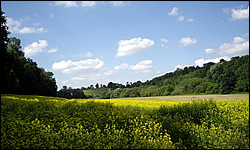 |
Ravine between Vauxcastille and Vierzy June 2008 |
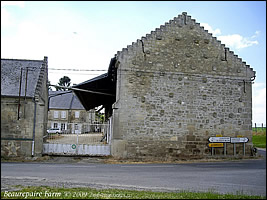 |
Beaurepaire Farm June 2008 |
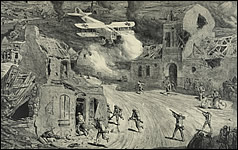 |
Aeroplane attacking troops from low height at Vierzy during Soissons attack.
L. Jonas. 1927 |
|
| |
Maps
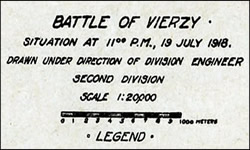 |
Battle of Vierzy - 2nd Division map done by 2nd Engineers |
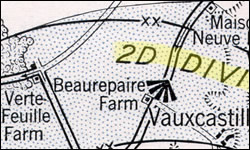 |
American Armies And Battlefields In Europe: a History, Guide, And Reference Book.
Washington: U.S. Govt. Print. Off., 1938. |
|
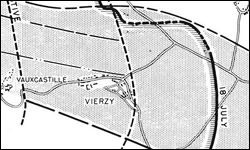 |
Operations of the American 1st and 2d Divisions in the Aisne-Marne 18—23 July 1918. |
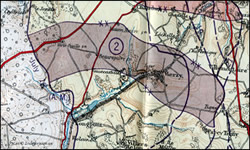 |
Map of 2nd Division attack at Vierzy, France. |
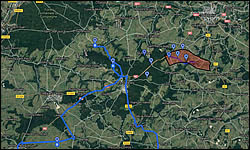 |
This is the approximate boundary of the path of the 2nd Division. The jump off line is on the west end. The French 1st Moroccan Division was just north of the 2nd Division and the 1st American Division was just north of the 1st Moroccan. |
|
| |
| Other Soissons / Vierzy related pages on this site |
| An Unsung Hero |
| 2nd Engineers at Soissons (July 17, 1918 to July 30, 1918) |
| 2nd Engineers Near Soissons-July 18th - 20th, 1918 |
| 2nd Division at Vierzy |
| |
Yanks At Hinges In Counter Offensive Below Soissons
The part taken by the 2nd United States Division in the counter-offensive was perhaps as brief and certainly as breathless as that of any division, American or French, which participated in the memorable struggle. The circumstances of its approach march, its attack and its battle were so typically American that they savor more of Shiloh, Chickamauga or Spottsylvania Court House than of incidents of European warfare.
The 2nd Division, whose regimental units were the same as during its fighting around Bouresches and the Bois de Belleau in June, but whose commander was now Maj. Gen. James G. Harbord, was relieved from its support position in the sector northwest of Chateau-Thierry on the night of July 16-17 and taken by motor bus to Marcilly near the western side of the Foret de Villers-Cotterets, the horse and motor-drawn transport going to the same vicinity by marching. |
| In the Forest |
Shortly after arrival there on the morning of the 17th, orders were received for an attack to be delivered at 4:35 o'clock next morning on the enemy's front along the eastern edge of the forest, which latter is an immense tract of very heavy timber, 10 or 12 kilometers wide at the point where the 2nd Division was approaching it and intersected in every direction by a maze of main and woodland roads.
Confusion in directions received from various sources as to the proper roads to follow resulted in the troops becoming more or less scattered through the woods and entangled with the mass of transport, American and French, which, because the forest gave concealment from airplane observation, was congested there behind the divisions going to the attack.
Extra ammunition and other supplies had to be issued to the troops; commanding officers had to receive at least hasty sketch maps and sufficient instructions to know where they were and what they were expected to do.
But by the time these essential preliminaries had been attended to in even part of the division, night had fallen. With darkness a heavy rain set in, and under the forest trees the night became so black that one could not see a pace ahead and the advancing troops seemed hopelessly blocked and delayed by the endless columns of wagons and trucks filling the roads. Officers of the line and staff, regimental commanders, enlisted men, worked madly, searching for and then directing or guiding confused companies or battalions toward their jumping off places.
As zero hour, 4:35 a.m., approached, it seemed that the assaulting line could by no human possibility be in place in time. But it was. Somehow the troops stumbled and dodged and ran, and foundered their way along the Route du Fait and the Laie des Tetes Salmon and the Paris-Maubeuge highway and the Route de Verriers and the Route du Chapeau des Cordoliers and a score of other roads and by-roads into the very northeastern corner of the dripping forest, and when, with the streaks of morning, the artillery barrage came down with a crash on the enemy's trenches, the first line battalions of the 23rd Infantry, on the right, the 9th Infantry and the 5th Marines on the left, went over behind it, breathless and staggering from two or three kilometers of double time to reach their places at the appointed second, but still active enough to shoot or bayonet or capture the first dazed Germans upon whom they hurled themselves, like specters coming out of the dawn. |
| The Second's Path |
Their sector, starting in the edge, of the forest between Chavigny Farm, on the right, and the Carrefour des Fourneaux, on the left, ran straight away northeast for about three kilometers over open, rolling country across Verte Feuille and Beaurepaire Farms. Then, swinging sharply to the right with the hill just west of Vauxcastille as pivot, and narrowing gradually to a breadth of less than two kilometers, it went east and slightly south across the ravine of Vauxcastille and that of the Bois Leonore, north of it; the ravine and village of Vierzy where, on the highland, it also crossed the longest tunnel of the railway line between Soissons and Paris; and then, still traversing lengthwise a high, flat ridge of the uplands devoid of buildings but interacted by various farm roads, it crossed the main Soissons—Chateau-Thierry highway between the villages of Taux and Hartennes and terminated in the Bois d'Hartennes.
Although the German counter-barrage opened promptly and although, owing to their precipitate advance, the infantry had neither machine guns nor hand or rifle grenades, Major Fechet's 2nd Battalion, leading the 23rd Infantry, with only rifles for weapons, was on its first objective, which included Beaurepaire Farm, 15 minutes after going over, and the leading battalions of the 9th Infantry and the 5th Marines reached their objectives at practically the same time.
By 6 o'clock streams of prisoners were already being conducted to the rear, and at 7 Col. Paul B. Malone, of the 23rd Infantry, trying to keep up with his men, on arriving at Beaurepaire Farm to establish a new post of command, found that they had already disappeared over the hill in front, in the direction of Vauxcastille. This village, on their second objective, the 2nd Battalion had, in fact, occupied at 6:45, leaving behind them on their headlong course, in the vicinity of Beaurepaire and elsewhere, several batteries of captured field guns and a complete hangar with large quantities of gasoline. |
| On Plateau Above Vierzy |
Swinging, now to the new direction. east by south, and with the 1st Moroccan Division keeping abreast on the left as it headed for Lechelle and the ravines beyond, and the 38th French Division keeping abreast on the right toward Montremboeuf Farm, the 2nd Division plunged into the ravine of the Bois Leonore and Vauxcastille, crossed its marshy woods and the embankment of the Soissons-Paris railway, after a brief but terrible struggle with German infantry and machine gunners, and by 9:30 a.m. was on the plateau overlooking Vierzy.
The western extremity of this village was taken immediately thereafter with a large number of prisoners, including, it was reported, a major general, but, though surrounded on the north, west and partly on the south the enemy continued to hold out bravely in the rest of the village and also in the unsubdued nests and dugouts of the Vauxcastille ravine, where the mopping-up troops of the support waves were encountering stubborn resistance.
The American casualties had already been severe, but now they became still more so. The batteries of the 2nd Battalion of the 15th Field Artillery came up to close action to combat the torrent of shells which the enemy's guns just east of Vierzy were sending over, and little by little through the afternoon the rear waves of the infantry were fed into the front line to take the places of those who fell.
During this time of bitter and disjointed fighting it was that many men in all the regiments engaged showed extraordinary heroism in the rushing and capturing of machine gun nests, as was done by Sgt. Louis Cukela, of the 5th Marines, who, having no hand grenades of his own, captured some German ones, worked his way alone to the rear of an enemy strong point that was holding up his line, rushed it with grenades, and captured two machine guns and four men. |
| Saved His Captain's Life |
It was in this vicinity that Cpl. J. Tickner, 9th Infantry, himself wounded, assisted his wounded captain to walk forward and direct the attack of their company until a shell took off tile officer's leg and again wounded Tickner, who thereupon, nothing daunted, compelled five German prisoners to carry the captain back four kilometers to a first aid station, thus saving his life.
And it was near Vierzy, too, that Sgt. Hercules Korgis, 23rd Infantry, lived up to the reputation of his given name by walking into a large dugout, extracting therefrom six German officers and 200 soldiers and marching them back, under a small escort, to the regimental prison cage, obliging them to police the field of wounded men on the way. |
| Engineers Go Through |
Vierzy had finally been captured, but all the ground traversed by the attack was covered with wounded, and no further progress could be made that night. The American troops, such of them as remained, dug themselves in, and the next morning the 2nd Engineers, following the Engineers' prerogative of digging all night and fighting all day, advanced through the remnants of the 9th infantry in the 6th Marines, through those of the 23rd infantry, and at 7 o'clock drove forward again more than 2 kilometers to Tigny, where, on the edge of the Bois d'Hartennes and less than a kilometer west of the Soissons—Chateau-Thierry highway, the depleted American units were brought to a stop, but entrenched themselves, and, aided by the men of the machine gun battalion, held every inch of their gains.
It was now evident that even the extraordinary driving power of the second division was exhausted, for it was reduced to little more than half its original strength, the 23rd infantry, for example having only 37 officers and 1,478 enlisted men left out of 90 officers and 3,400 enlisted men, while the troops had received no cooked food since leaving Montreuil-aux-Lions, on the night of July 16. It was relieved, accordingly, by the 58th French division during the night of the 19th–20th, rested until noon the next day in the forest, and then marched to St. Etienne, where it bivouacked until at 7 a.m. on July 21.
Spewed out of the woods in the gray dawning, the 2nd Division had advanced 8 kilometers in 26 hours and one of its regiments, the 23rd, alone had taken prisoner 75 officers and 2,100 men from 11 different German regiments belonging to the XIVth Reserve, the XLIInd, the XLVIIth, the XLVth and the CXVth German Divisions, besides capturing two batteries of 150mm. field guns, five batteries of 70mm., one battery of 210mm., about 100 machine guns and 15,000 rounds of 77mm. ammunition. No available information gives the prisoners and booty taken by the rest of the division, but at least 878 more prisoners were captured, and the division had contributed its full share toward giving to the Marne salient a place in Prussian history beside that of Jenna. |
| (To Be Continued) |
| The Stars and Stripes January 3, 1919. |
|
The Victory of Soissons
Fifth Marines Attack July 18, 1918, Under Terrific Enemy Counter-Barrage. Second Battalion Takes Verte Feuille Farm.
First Battalion Captures Chaudun. Third Battalion and Auxiliaries Seize Vierzy. Sixth Marines Gallantly Carry On. Second Division, Including Fourth Brigade of Marines, Advances Over 6 Miles, Captures 3,000 Prisoners, 11 Batteries of Artillery, More than 100 Machine-Guns, Minenwerfer and Supplies. With First Division Definitely Turns Tide of War for Allies. |
| BY MAJOR EDWIN N. McCLELLAN, OFFICER IN CHARGE, HISTORICAL DIVISION, U. S. M. C. |
ON July 11, 1918. Brig. Gen. James G. Harbord, commanding general of the Marine Brigade, received notification of his appointment as a major general, and two days later left on a five days' leave of absence. As Col. Neville had been evacuated to a base hospital after leaving the Chateau-Thierry sector, Lieut. Col. Harry Lee assumed temporary command of the brigade. Maj. Gen. Harbord and Col. Neville both returned in time to enter the Aisne-Marne offensive, the former in command of the Second Division and the latter in command of the Fourth Brigade.
Of the six Allied offensives taking place in 1918 on the Western Front, designated by the Americans as major operations, the Fourth Brigade of Marines, with the other units of the Second Division, participated in three, the first being the vast offensive known as the Aisne-Marne, in which the Marine Brigade entered the line near Soissons.
On July 17, 1918, the first Moroccan Division and the First and Second Divisions of American Regulars were hurriedly and secretly concentrated. by terribly fatiguing, forced night marches over roads jammed with troops, artillery, and tanks. through rain and mud, in the Bois de Retz, near Soissons. Headquarters of the Fourth Brigade was established at Vivieres.
The getting to the "jump-off" on time for this operation will always share in Marine Corps history with the glorious victory that followed.
Early on the morning of July 18, 1918, Marshal Foch threw these three picked divisions at the unsuspecting Germans with overwhelming success, and again on the following day.
A brief description of the first attack on July 18, 1918, is contained in the History of the Fourth Brigade. reading substantially as follows: |
Late during the afternoon of July 17, 1918, orders were received that the Fourth Brigade of Marines would attack at 4:35 a. m. on July 18. 1918. The Fifth Marines were designated to attack, with the Sixth Marines following in support. After considerable difficulty, due to the darkness and the congestion of the road leading through the forest, the Fifth Marines arrived at the jumping-off position.
The Allied artillery preparation had been going on since 4:35 a. m., increasing in intensity until just before the hour set for the attack, which was 6:00 a. m., when the Fifth Marines attacked under a teriffic enemy counter-barrage. The advancing waves burst through the barbed-wire interlaced among the trees of the forest and soon carried the enemy's front line. Overhead shrapnel caused most of the losses that day. The secondary positions were speedily taken and many prisoners and much materiel captured. The First Battalion, Fifth Marines, occupied the extreme left of the Second Division line with the 49th Company in combat liaison with the Moroccan Division of French Colonials on the left. To the right was the Second Battalion, Fifth Marines, with the 51st Company acting as liaison company with the Ninth Infantry of the Third Brigade on the right. The Second Battalion, Fifth Marines, speedily took Verte Feuille Farm and thus gained their first objective.

Here the Sixth Machine Gun Battalion of Marines arrived after an all-night march, having been forced to carry all its guns, ammunition and machine-gun equipment by hand. Companies of the Machine Gun Battalion were assigned their combat missions. At the crossroads two kilometres north of Beaurepaire Farm the attacking waves of Second Battalion, Fifth Marines, changed direction to 115 degrees and soon had carried the advance so far as to reach the artillery positions of the Germans. The troops were continually subjected to machine-gun fire and the bombs from enemy planes circling low overhead. At the ravine running north from Vauxcastile strong machine-gun resistance was met and the Second Battalion, Fifth Marines, paused while tanks worked around them and broke the opposition. Owing to the rapidity of the advance the companies of the battalion by this time had become somewhat scattered and stretched from Maison Neuve Farm to Vauxcastile. Late in the afternoon the final objective of the Second Battalion, Fifth Marines, had been carried and the night was spent in the ravine running northwest from Vierzy. In the meantime, a company of the First Battalion, Fifth Marines, found its left exposed, swerved to the left, and after stiff fighting, captured Chaudun. Late in the afternoon of July 18, 1918, a platoon of the 49th Company of the Fifth Marines, three companies of the Third Battalion of the Fifth Marines, and the Eighth Machine Gun Company of the Fifth Marines attacked and captured the town of Vierzy, after which a line was formed extending north from this village. Following the advance of the Fifth Marines, both the Division and Brigade Headquarters had moved forward, the Division being established at Verte Feuille Farm and the Brigade in a cave in Vierzy. In the meantime. the Sixth Marines had followed the attack and advance of the Fifth Marines about three kilometers in rear of the attacking troops. |
The Journal of Operations, Second Division. describes the division's fighting on the 19th as follows:
Line held by the Third Brigade following attack of evening of July 18th ran about three kilometres west of SOISSONS-CHATEAU-THIERRY road and parallel to it, from the old French trenches southwest of CHARANTIGNY to a point on the Vierzy-Tigny road two kilometres west of TlGNY. Field Order No. 16, Second Division, 3:00 a. m., July 19th, directed that the attack take the line HARTENNES, ETAUX (inclusive), BOIS de HARTENNES to BOIS de CORNCOlS (inclusive). Artillery preparation by Second Artillery Brigade to begin at 6:00 a. m. according to orders of the C. G. of the artillery brigade. The infantry attack was to be made by the Sixth Marines and the Sixth Machine Gun Battalion, under Lieutenant Colonel Harry Lee. The First Battalion, Second Engineers, was designated as support. Passage of the lines was to be effected at 7 :00 a. m., the troops then in the line to remain there until the attack had attained its objective. |
At 3:15 the afternoon of July 19th the Commanding General sent word to General Ely that he had directed Colonel Lee to dig in where he then was and to hold. "Please let the troops know that their work is considered to be very gallant and that the failure of the troops on our left and right to keep pace with our advance makes it necessary to dig in and hold the line as it now is," General Harbord wrote.
Although the orders for the attack contemplated a passage of the lines at 7 :00 a. m., this was not actually accomplished until about 9 o'clock. At 6:46 Colonel Lee reported to his Brigade Commander that he was at the railroad station at Vierzy with his three battalions and three Machine Gun Companies, 6th, 73rd and 81st. Colonel Lee reported favorable progress for the first hour of the advance. The First Battalion, Second Engineers, in line when the Sixth Marines passed through, followed them in the attack. Various reports came in during the morning indicating that Tigny had been captured, but these proved untrue.
Colonel Lee attacked with all three battalions in line, First, Third and Second, from right to left. Heavy casualties were reported from all attacking units, and constant calls for reinforcements came back. At 11:45 Colonel Lee sent this message to the Division Commander: "Reports indicate growing casualties, amounting heavy, say about 30 per cent. Seventy-eighth Company by runners say have only one platoon left. All are requesting reinforcements and M. G. and Chauchat ammunition. First Battalion reports no French troops on right, and are held up 300 yards in front of Tigny. Have in line from right, First, Third and Second Battalions, Reserves, Battalion Engineers, Headquarters Company and two companies Sixth Machine Gun Battalion have ordered line dig in." |
The Chief of Staff sen t the following to Colonel Lee at 1.30 p. m.:
"The Division Commander desires that you dig in and entrench your present position and hold it at all costs. No further advance is to be made for the present. He desires to congratulate your command upon its gallant conduct in the face of severe casualties." |
The Division was relieved the night of July 19th-20th by units of the French 6th and 11th Tirailleurs. |
The American commander in chief in his first report stated:
The place of honor in the thrust toward Soissons on July 18 was given to our First and Second Divisions, in company with chosen French divisions. Without the usual brief warning of a preliminary bombardment, the massed French and American artillery, firing by the map, laid down its rolling barrage at dawn while the Infantry began its charge. The tactical handling of our troops under these trying conditions was excellent throughout the action. * * * The Second Division took Beaurepaire Farm and Vierzy in a very rapid advance, and reached a position in front of Tigny at the end of its second day.
In his final report he stated:
General Petain's initial plan for the counterattack involved the entire western face of the Marne salient. The First and Second American Divisions, with 'the First French Moroccan Division between them, were employed as the spearhead of the main attack, driving directly eastward, through the most sensitive portion of the German lines to the heights south of Soissons. The advance began on July 18, without the usual brief warning of a preliminary bombardment, and these three divisions at a single bound broke through the enemy's infantry defenses and overran his artillery, cutting or interrupting the German communications leading into the salient. A general withdrawal from the Marne was immediately begun by the enemy, who still fought stubbornly to prevent disaster. * * *
The Second Division advanced 8 kilometers in the first 26 hours, and by the end of the second day was facing Tigny, having captured 3,000 prisoners and 66 field guns. It was relieved the night of the 19th by a French division. The result of this counter offensive was of decisive importance. Due to the magnificent dash and power displayed on the field of Soissons by our First and Second Divisions the tide of war was definitely turned in favor of the Allies.
Major General James G. Harbord, commanding the Second Division in this operation, describes the two days' fighting of his division in these words:
It is with keen pride that the division commander transmits to the command the congratulations and affectionate personal greetings of General Pershing who visited the division headquarters last night. His praise of the gallant work of the division on the 18th and 19th is echoed by the French high command, the Third Corps commander, American Expeditionary Forces, and in a telegram from the former division commander. In spite of two sleepless nights, long marches through rain and mud and the discomforts of hunger and thirst, the division attacked side by side with the gallant First Moroccan Division and maintained itself with credit. You advanced over 6 miles, captured over 3,000 prisoners, 11 batteries of artillery, over 100 machine guns, minnenwerfers, and supplies. The Second Division has sustained the best traditions of the Regular Army and the Marine Corps. The story of your achievements will be told in millions of homes in all Allied lands to-night. |
Following the advance of the first day, brigade headquarters was moved forward to a cave in Vierzy.
Colonel Logan Feland was in command of the Fifth Regiment during the Aisne-Marne offensive, near Soissons, and continued in command of it with the exception of two days in July, 1918 (when Brigadier General Lejeune commanded the Fourth Brigade and Colonel Neville the Fifth Regiment), until March 21, 1919, when he was relieved by Colonel Harold C. Snyder, who retained command until the date of demobilization.
The Fourth Brigade was relieved about midnight July 19, 1918, and after remaining in a reserve position until July 22, 1918, marched to an area farther in the rear, but still in a reserve position, brigade headquarters being established at Taillefontaine. After final relief from this active sector the brigade was billeted July 24-25, 1918, in an area around Nanteuil-le-Haudouin, brigade headquarters being established at Nanteuil. The brigade remained in this area until july 31, 1918.
On July 25, 1918, Brig. Gen. John A. Lejeune arrived, and assumed command of the Fourth Brigade on July 26, 1918, General Orders, No. 16, reading as follows:
I have this day assumed command of the Fourth Brigade. U. S. Marines.
To command this brigade is the highest honor that could come to any man. Its renown is imperishable and the skill, endurance, and valor of the officers and men have immortalized its name and that of the Marine Corps.
Brigadier General Lejeune retained command until July 29, 1918, when he became commanding general of the Second Division, relieving Major General Harbord, who left to assume command of the Services of Supply. Colonel Neville, on this latter date, resumed command of the Fourth Brigade. |
|
Record of Casualties Reported In Soissons Sector
| Organization |
Killed & Died Wounds |
Missing |
Severely Wounded |
Slightly Wounded |
Gassed |
Totals |
| |
Off |
Men |
Off |
Men |
Off |
Men |
Off |
Men |
Off |
Men |
Off |
Men |
| 3rd. Brig. |
20 |
238 |
4 |
575 |
28 |
186 |
5 |
716 |
|
61 |
57 |
1776 |
| 4th Brig. |
7 |
165 |
|
145 |
11 |
91 |
50 |
1098 |
2 |
23 |
70 |
1522 |
| 2nd F. A. |
2 |
12 |
|
3 |
5 |
72 |
4 |
34 |
11 |
66 |
22 |
187 |
| 2nd Engs. |
|
26 |
|
35 |
|
17 |
2 |
84 |
3 |
30 |
5 |
192 |
| 4th. MG. Bn. |
|
3 |
|
5 |
|
14 |
|
39 |
|
1 |
|
62 |
| All other organizations |
|
8 |
|
1 |
|
7 |
|
23 |
|
10 |
|
49 |
| Totals |
29 |
452 |
4 |
764 |
44 |
387 |
61 |
1994 |
16 |
191 |
154 |
3788* |
|
| Image *The total on the image is a typing error. It should be 3788 as stated here. |
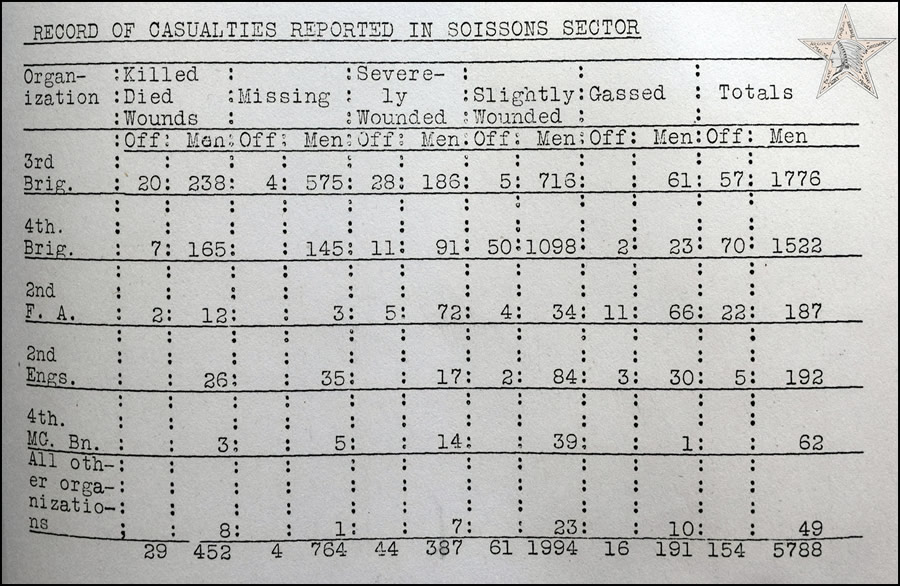 |
Records Of The Second Division (Regular) Volume 6; Operation Reports — War Diaries — Journal of Operations
Second Division Historical Section, The Army War College, Washington, D. C. |
|
|
| |
|
| |
|
| |
|

